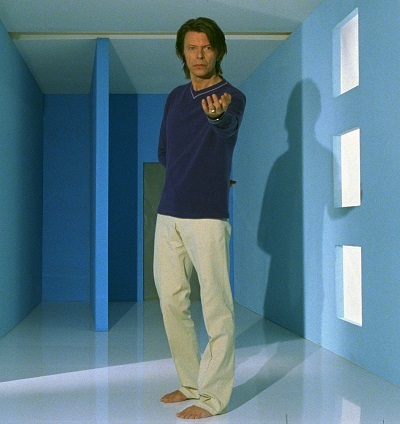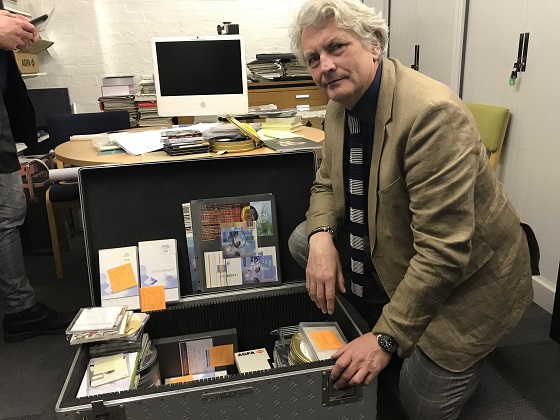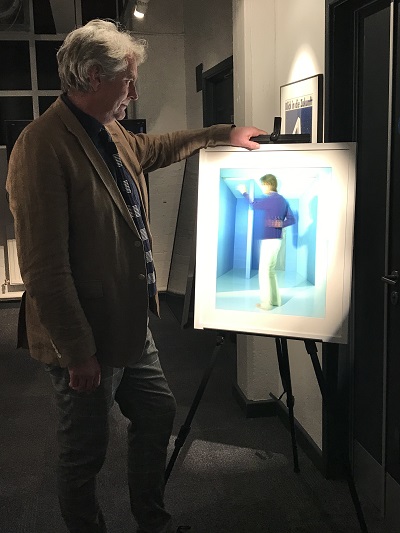Lost footage of David Bowie filmed by a De Montfort University Leicester (DMU) professor who had struck up a friendship with the legendary artist is to be shown for the first time in the UK on Friday.

A still from the Bowie footage
Professor Martin Richardson, one of the UK’s leading authorities on holography – the creation of three-dimensional images – became friends with Bowie in the 1990s and ended up producing the 3D version of the cover photo that appeared as an insert with the rock star’s 1999 album "hours...”.
But the year before that, Bowie, who was famously fascinated by and involved in the creation of new technology, allowed Professor Richardson to shoot some experimental film of him in Blue Sky Studios, Kensal Rise, London.
It was used to create a giant moving hologram of Bowie, who would have been 73 today, beckoning to the viewer.
The original film has been stored away in a metal chest in Professor Richardson’s studios at De Montfort University for several years, but he has now turned some of the 30 minutes of 35mm film into a short digital recording of Bowie walking towards the camera and doing various poses.
This recording will be shown for the first time in the UK, along with the giant hologram, at the ‘Bowie; Oddity to Mars’ immersive show at the planetarium in Leicester’s National Space Centre on Friday.
The two-day event sold out almost immediately when tickets went on sale last month but, until now, visitors to the event had no idea that the rare footage of Bowie would be shown. The footage carries even more cultural importance due to Bowie’s unexpected death at the age of 69 on January 10, 2016.
Professor Richardson said meeting and working with Bowie was one of the most important and seminal moments in his life.
His friendship began in 1994 when he was invited to an art exhibition ‘Minotaur: Myths and Legends’ featuring some of Bowie’s work.
Professor Richardson said: “I was in touch with David Bowie’s art manager Kate Chertavian. She was looking at me possibly going on to her books so she visited my studios totally out of the blue.
“She then sent me an invite to the exhibition off New Bond Street in London. I went down on the opening night but Bowie did not arrive until about 10.30pm.
“By then people were inebriated, but I wasn’t drinking. My initial feeling was I related to him being a vulnerable artist, standing in front of his art work with all these people surrounding him.
“So I went over to Bowie, introduced myself and we immediately struck up a friendship.

Professor Richardson and the trunk full of Bowie-related media and correspondence
“I do remember at the time he was incredibly concerned that the works in the gallery were not hanging properly so we proceeded to go around and straighten all the pictures.
“The following day I had a phone call from Alan Edwards who is still my friend. He does music PR.
“Alan arranged a time to visit my studio along with Bowie’s personal assistant. They saw the holograms and said ‘this is perfect for our next project’.
“A couple of weeks after that I received a phone call to visit New York to meet Bowie and discuss what the project was. I jumped on a plane and met him at the recording studio and we spent a week, on and off, discussing ideas.
“There I was in the studio with David Bowie and Reeves Gabrels (long-time Bowie guitarist and co-producer of “…hours”) and the most memorable moment, apart from chilling out with him, was treading on his personal set of headphones and breaking them, which he roared with laughter about.
“I think the thing we had in common was we were both born in Brixton, South London. We both have a cutting sense of humour that borders on irony and we see the funny side of everything.
“I would like to think of myself as creative and there is something about the creative mind that moves and jumps from one subject to another. People saw that in David and thought it was ignorance, but it wasn’t.
RELATED NEWS
DMU designers to exhibit at Bowie celebration
Be inspired. Come to the next DMU Open Day
Nine places to catch live stuff in Leicester
“It was him jumping across lots of ideas. I liked that. He always had a notebook with him with lots of drawings in them. He also carried around an old beaten up cassette player, so if an idea came to him he would sing into the player. He carried an old WWII gas mask case containing his notebook, tape recorder and, of course, his cigarettes.”
The experimental 3D film was shot in July 1998, but at the time Professor Richardson was worried it might not happen.
He explained: “I met up that morning with John Wiltshire the technical assistant. We had developed a camera system on a 15ft rail with a 35mm camera and what is known as a shift lens.
“We had to wait outside in a VW Camper while Bowie was being interviewed by all the music press – NME, Q, Melody Maker – and that was followed by Tim Bret Day (famous pop and fashion photographer) doing promo shoots.
“We were sat there for six hours and at 5pm we were left thinking ‘this is not going to happen’. Bowie’s personal assistant came outside and said ‘We forgot you were here’, he opened the warehouse doors, we unloaded the kit and set-up in 15 minutes.
“Bowie, by that time, had de-robed and turned up wearing a green fur coat and he came up to me using his best Jack Nicholson voice saying ‘Are you okay kid?’ – he was always doing impressions.
“Then that quickly turned into a John Prescott impression (Deputy Prime Minister at the time).
“Bowie said to me ‘When you’ve done your bloody hologram it will be up and down the width and breadth of the country. I am going to make you famous’.
“He got back on the sound stage and said ‘right, what do you want me to do’ and I thought ‘I am going to direct David Bowie, the super rock star I idolised as a boy because of Ziggy Stardust right through to the Thin White Duke!’
“I filmed 30 minutes of David doing various poses and he could not have been nicer.
“Two weeks later we got the phone call from Virgin to commission 500,000 hologram inserts for the album ‘…hours’.”
The friendship continued for another five years.

Prof Richardson and one of the holograms
Professor Richardson said: “David was kind enough to write the quote for the back cover of my book on holograms and we kept in regular touch talking about various technical developments.”
In 2004 Bowie suffered a heart attack, underwent heart surgery and stepped out of public life.
So why is there a continued fascination with holography when so many people see digital media as the way forward?
Professor Richardson said: “I think Bowie was fascinated because the big difference between AI digital media and holography is the point of interaction.
“When you wear an augmented reality headset you have to enter that world. You are aware of the pixels, the limitations of the head gear and you end up having a limited experience.
“A hologram does not have to be turned on. There is an instant connection with your primal senses that goes beyond anything digital can offer. When you look at a hologram you are experiencing something there and then.
“Digital work follows a predetermined set of rules which have been written by probably 1,000 technicians before you get to experience it. As the inventor of holography, Dennis Gabor said: “It is all in the psychology”.”
Posted on Wednesday 8 January 2020